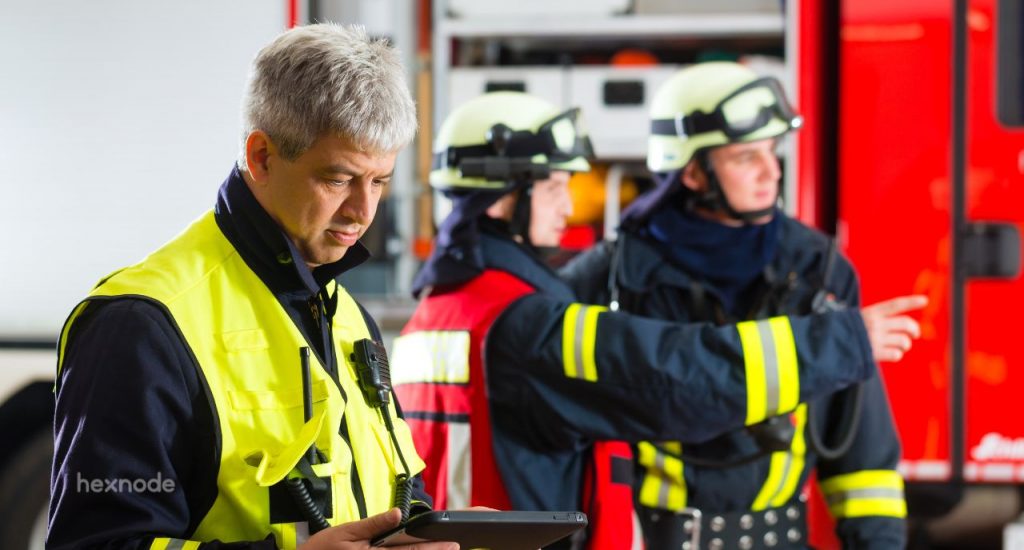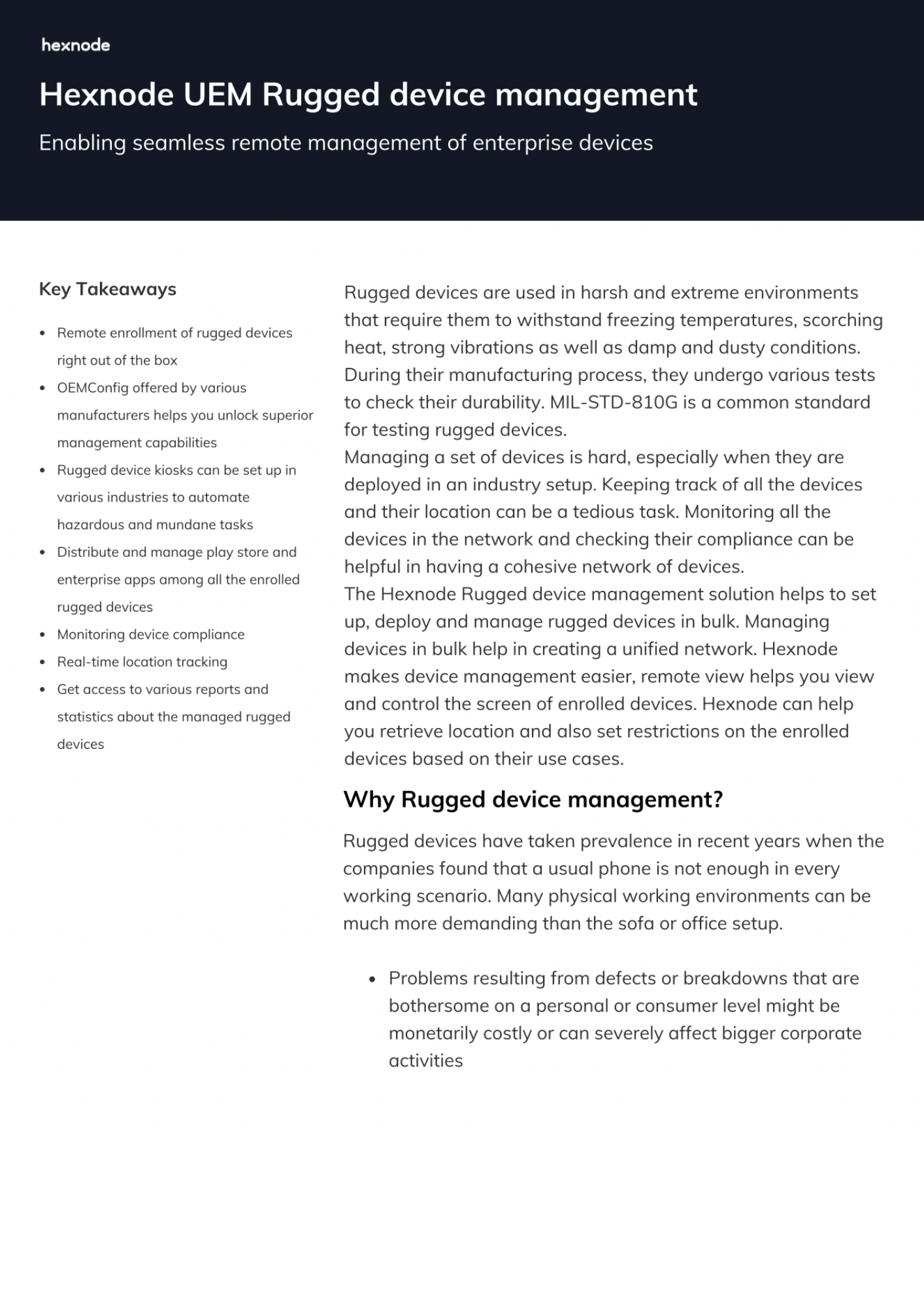Why transportation and logistics industry needs rugged devices
Curious to know more about rugged devices and their role in the transport and logistics industry. Swoop right in!

Get fresh insights, pro tips, and thought starters–only the best of posts for you.
Alie Ashryver
Jun 7, 2023
18 min read

“9-1-1, what’s your emergency?”
We’ve all heard this line somewhere or the other, haven’t we? If not in real life, then at least while binging our favorite law enforcement or medical dramas like Brooklyn Nine-Nine or Grey’s Anatomy. Well, either way, there is no denying that the question works like a temporary balm of hope and strength for those in distress, both on and off the screen. So, of course, our guys need to be tough enough to help others in distress. After all, amidst the chaos and urgency, they must be calm and dedicated to fulfilling their roles – saving lives. They mustn’t just toughen themselves up but also have sturdy and not-so-easy-to-break tools that don’t crack under pressure.
Yes sir, it is indeed the glossary! How can we truly comprehend the significance of rugged devices if we don’t know who and what these first responders and emergency services are and what exactly sets the ‘rugged’ devices apart? Let’s go digging, shall we?
So, first responders, just as the name suggests, are individuals who are typically the first to arrive at the scene of an emergency or crisis. Accordingly, professionals from various fields like law enforcement, firefighting, emergency medical services (EMS), and search and rescue teams make the cut for the first responders’ category. Primarily, they are tasked with providing immediate assistance, assessing the situation, and initiating necessary actions to mitigate risks and save lives.
The front-line professionals who provide immediate assistance and take necessary actions to address the situation belong to various walks of life that include but are not limited to:
Why ThirdEye X2 MR Glasses are the right tech for first responders?
Emergency services refer to the organizations and resources dedicated to responding to emergencies and providing critical assistance in times of crisis. These services encompass a wide range of professionals, including police officers, firefighters, paramedics, emergency medical technicians (EMTs), and dispatchers. Their collective efforts aim to protect public safety, handle medical emergencies, extinguish fires, maintain order, and ensure the overall well-being of communities during challenging situations.
Emergency services include a wide range of organizations, from local fire departments and ambulance services to government agencies like FEMA and the Red Cross. The different entities and agencies working together to address various aspects of emergency management include but are not limited to:
Rugged devices are specialized electronic devices designed to withstand harsh and demanding environments. Unlike standard consumer devices, rugged devices are built to endure extreme temperatures, moisture, dust, vibrations, impacts, and much more.
Rugged devices often feature reinforced casings, shock-resistant components, waterproofing, and extended battery life. These devices come with advanced features such as GPS, communication capabilities, barcode scanners, thermal imaging, and specialized software applications, enabling first responders to effectively perform their tasks, maintain situational awareness, and communicate critical information in the field. They are specifically engineered to meet the unique needs of first responders and emergency services, offering durability, reliability, and enhanced functionality in challenging operational conditions.
Well, why not? Okay, we get it. All talk is not going to cut it! And so, let’s take the rugged devices out for a spin and see why they are the best friend every first responder needs and the best asset for any emergency service.
First responders and emergency services work in challenging environments where electronic devices are subject to physical damage, water, dust, and temperature fluctuations. Rugged devices are constructed to withstand harsh environments and demanding conditions. They are built with robust materials and undergo rigorous testing to ensure they can endure extreme temperatures, vibrations, shocks, drops, and exposure to water or dust. These devices are engineered to be more resistant to physical damage when compared to standard devices.
Rugged devices often feature reinforced casings, shock-absorbing materials, and sealed ports or connectors. Consequently, these features provide the devices additional protection against impact, dust, moisture, and other environmental elements. They operate reliably in challenging environments such as construction sites, industrial facilities, or outdoor settings. They are less likely to fail or malfunction, ensuring that first responders and emergency services can communicate and access critical information when they need it most.
Rugged devices often have longer battery life than standard devices, which is essential when first responders and emergency services personnel are working in remote locations or during long shifts. Additionally, rugged devices are built to have an extended lifecycle and withstand heavy usage. They can endure prolonged exposure to rough conditions without compromising their performance or reliability. Accordingly, this ensures that first responders and emergency service personnel can rely on these devices for an extended period without frequent replacements.
Rugged devices often come with specialized features such as barcode scanners, thermal imaging cameras, NFC (Near Field Communication) capability, long-lasting batteries, GPS functionality, and dedicated emergency buttons for quick access to critical functions. They are designed to enhance the effectiveness and efficiency of tasks specific to emergency situations.
Rugged devices are often designed to work with specific software and systems used by first responders and emergency services personnel. This ensures that they can access the information and applications they need to perform their duties effectively. Rugged devices are often equipped with advanced wireless connectivity options, such as 4G LTE or satellite communication, to ensure reliable and uninterrupted communication in remote or disaster-stricken areas. They may also support interoperability with existing communication systems used by emergency services for seamless integration.
Rugged devices are designed to be user-friendly and easy to operate, even in high-stress environments. This is important for first responders and emergency services personnel who may need to use the device quickly and efficiently in an emergency situation.
Rugged devices may have a higher upfront cost than standard consumer-grade devices, but they are often more cost-effective in the long run. They last longer, thus reducing the need for frequent replacements and repairs.
Manufacturers usually manufacture the rugged devices to meet regulatory compliance standards, such as FCC, CE, or MIL-STD-810G, which are important for industries such as healthcare, military, and public safety.
Impressive, right? There really is no reason to not campaign for and be in favor of rugged devices for first responders and emergency services.
Well, you definitely know how to ask the right questions! However, before we find the answer to this question, we should understand why we must secure and manage rugged devices for first responders and emergency services in the first place. Aside from the obvious reasons, securing and managing rugged devices for first responders and emergency services is crucial for several reasons that include:
By prioritizing the security and management of these devices, emergency services can effectively carry out their responsibilities while ensuring the safety and privacy of the individuals involved.
So now, how do we go about securing and managing these rugged devices for first responders and emergency services. Well, the answer is Unified Endpoint Management (UEM). UEM solutions have been making waves in the endpoint security and device management market segment. Businesses and organizations across the globe are turning towards this particular concept (more like a solution 😉) to attend to their enterprise security needs. And so, a solid UEM solution (like Hexnode!) plays a vital role in securing and managing rugged devices for first responders and emergency services.
Well, why not! I know that’s not the answer you were looking for. So, here are some reasons that might convince you that UEM solutions can deal with the pressure of securing and managing rugged devices.
UEM provides a centralized platform to manage and control a diverse range of rugged devices, including smartphones, tablets, laptops, wearables, and IoT devices. This allows administrators to enforce security policies, configure settings, deploy software updates, and track devices from a single interface. Centralized management ensures consistency, efficiency, and ease of administration across a large fleet of devices.
First responders and emergency services often handle sensitive and confidential information, including personal data, operational details, and critical communications. UEM enables comprehensive security measures such as device encryption, remote lock and wipe, password policies, and a lot more. Consequently, UEM helps protect against data breaches, unauthorized access, and malware attacks, ensuring the integrity and confidentiality of sensitive information.
UEM allows administrators to enforce strict security policies and compliance standards across all rugged devices. Accordingly, they can define and enforce device management policies to configure settings and restrict network access, application usage and data sharing. UEM minimizes the risk of accidental data leakage, improper device usage, and non-compliance with regulations.
UEM simplifies processes like deployment, updation, and removal of applications on rugged devices. It enables administrators to remotely push essential applications, software updates, and security patches to all devices simultaneously. This ensures that first responders have the latest tools and functionalities available. UEM can also restrict the installation of unauthorized or malicious applications, reducing the chances of device compromise.

Rugged devices are most useful in harsh and remote environments. Unlike everyday use devices, they are built for particular purposes. So, it is important that a management suite catering to their specific needs is used.
Download datasheetRugged devices are valuable assets for first responders and emergency services. UEM provides real-time visibility and tracking capabilities, allowing administrators to monitor the location and status of all devices. In case of loss or theft, administrators can remotely track and locate the devices, trigger alarms, and perform remote wipes if necessary. UEM also assists in managing device inventory, ensuring accurate records of device ownership, allocation, and maintenance.
First responders and emergency services rely on their devices to function seamlessly during critical operations. UEM enables remote support and troubleshooting capabilities (like remote view and control). And so the IT personnel can diagnose and resolve issues without physical access to the devices. This reduces downtime, enhances productivity, and ensures that devices are operational when they are needed the most.
These capabilities enhance the overall security, efficiency, and reliability of rugged devices in critical situations.
Well, just saying UEM is the answer to securing and managing your rugged devices would be like leaving you high and dry. Fret not, though! I have every intention of pointing y’all toward a robust UEM solution that can take care of all things rugged device management. This is where Hexnode comes into play. Hexnode’s rugged device management solution boasts a comprehensive set of features for managing and securing rugged devices. Indeed, an assortment of features that can ease the lives of first responders and emergency services personnel! Let’s sneak a quick peek, shall we?
First responders and emergency services are an indispensable part of our society. When disaster strikes, whether it’s a natural disaster like a hurricane or a man-made emergency like a fire or a car crash, these brave men and women are the first to rush in and help. They are the ones who put themselves in harm’s way to save lives and ensure that everyone is safe. So, of course, as we saw earlier, they have to be tough. The first responders and emergency services personnel who rush to the scene, facing chaos, danger, and the race against time to save lives, deserve the very best of helpers. And so, let us hope that the next time the first responders reach their target site, they are not just armed with their bravery but also trusty and sturdy rugged devices.
Ooo, and while you’re cheering for the future of first responders and emergency services don’t forget to check out Hexnode’s rugged device management features. See you, then!
Are you ready for your 14 days of easy and efficient rugged device management with Hexnode?
Get your free trial